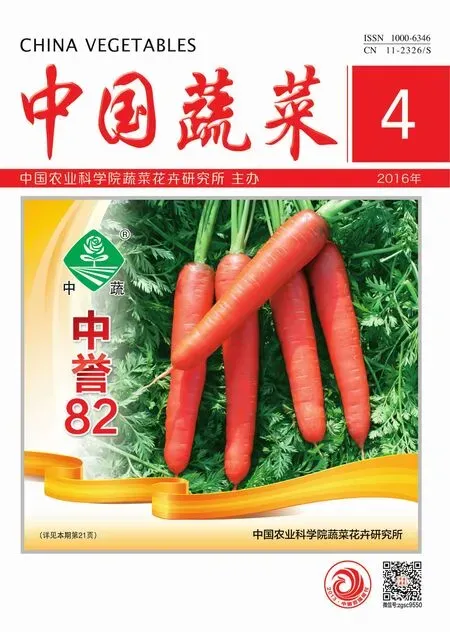警惕烟粉虱传播的番茄褪绿病毒病在我国快速扩散
郑慧新夏吉星周小毛张友军*
(1湖南农业大学农药研究所,湖南长沙410128;2中国农业科学院蔬菜花卉研究所,北京 100081)
警惕烟粉虱传播的番茄褪绿病毒病在我国快速扩散
郑慧新1,2夏吉星2周小毛1张友军2*
(1湖南农业大学农药研究所,湖南长沙410128;2中国农业科学院蔬菜花卉研究所,北京 100081)
摘 要:2013~2014年连续两年对我国番茄主产区烟粉虱携带番茄褪绿病毒(ToCV)的情况进行了监测。结果发现,在2013年全国采集的16个地区烟粉虱样本中,山西运城、山西太原、山东商河、陕西杨凌、北京海淀5个地区烟粉虱携带ToCV,烟粉虱样品携带ToCV的带毒率均低于20%;在2014年全国采集的17个地区烟粉虱样本中,北京海淀、浙江杭州、山东商河、山西运城、陕西杨凌、内蒙古等6个地区的烟粉虱携带ToCV,且除北京外带毒率均大于50%。山西、陕西、浙江、内蒙古地区ToCV的发生均为首次报道,且2014年烟粉虱田间种群带毒率明显高于2013年。番茄褪绿病毒病的快速扩散趋势需引起高度重视。
关键词:烟粉虱;番茄褪绿病毒;检测
郑慧新,女,硕士研究生,专业方向:昆虫毒理学,E-mail:zhenghx0124@163.com
番茄褪绿病毒(Tomato chlorosis virus,ToCV)是我国新报道的对番茄、辣椒等茄科蔬菜造成毁灭性危害的RNA病毒,属长线形病毒科(Closteroviridae)毛形病毒属(Crinivirus)。ToCV侵入植株初期,症状表现不明显,随后叶脉间发黄褪绿,颜色加深,叶片变厚、边缘卷曲变脆,发病由老叶向新叶发展,造成植株发育受阻,果实减产(Wintermantel & Wisler,2006)。该病毒寄主广泛,不仅侵染番茄、辣椒、甜椒等茄科植物,还能侵染苋科、番杏科、藜科、夹竹桃科、菊科和白花丹科等7科植物(Wintermantel & Wisler,2006)。ToCV发病率高且传播速度快,据报道,发病温室内感染ToCV的病株率为20%~100%,感病植株减产10%~40%,造成果实商品性下降,给种植户造成巨大的经济损失(刘永光 等,2014)。1998年美国佛罗里达州首次发现ToCV(Wisleret et al., 1998b),随后该病毒在全球范围内迅速扩散,目前已在北美洲(Wintermantel et al.,2001; Alvarez-Ruiz et al.,2007;Castro et al.,2009; Sundaraj et al.,2011)、南美洲(Barbosa et al.,2008;Arruabarrena et al.,2014)、欧洲(Louro et al.,2000;Dalmon et al.,2005; Lozano et al.,2006;Papayiannis et al.,2006; Parrella & Scassillo,2006; Bese et al.,2011 )、非洲(Lett et al.,2009; Fiallo-Olivé et al.,2011)和亚洲(Segev et al.,2004; Abou-Jawdah et al.,2006; Çevik & Erkıß,2008)等多个地区发生,我国于2012年在北京首次检测出ToCV(Zhao et al.,2013)。
ToCV只能依靠媒介昆虫传播,主要媒介昆虫是烟粉虱(Bemisia tabaci)、温室白粉虱(Trialeurodes vaporariorum)和纹翅粉虱(Trialeurodes abutilonea)(Wisler et al.,1998a)。烟粉虱是世界性入侵害虫,可以传播至少200种植物病毒病。烟粉虱体型小,繁殖速度快,寄主广泛,只要烟粉虱携带ToCV,当地作物就更易受到侵染。因此,检测烟粉虱携带ToCV的情况,是了解采集地区番茄带毒情况及ToCV发生规律快速而有效的方法,有助于根据烟粉虱的发生和带毒情况采取合理的防治措施,控制ToCV的暴发。
本试验采集了2013~2014年全国部分地区番茄植株上的烟粉虱样本,通过RNA提取和PCR检测,鉴定该地区采集的烟粉虱样本是否带毒,检测带毒地区烟粉虱带毒率。通过对比2013年与2014年烟粉虱携带ToCV的情况,明确其发生发展规律,为我国ToCV的综合防控提供科学指导。
1 材料与方法
1.1烟粉虱样本的采集
2013~2014年在山西运城、山西太原、山东商河、陕西杨凌、北京海淀、辽宁沈阳、河北廊坊、江苏扬州、河北保定、新疆乌鲁木齐、内蒙古、黑龙江哈尔滨、江西南昌、上海、湖南长沙、浙江杭州、海南海口、山东青岛、安徽、天津西青、云南元谋、河南、广东广州、江西南昌、四川自贡等地区采集番茄植株上的烟粉虱成虫样本,各地采集样本数量均为300个(表1)。采集到的样本置于95%的乙醇中,-20 ℃保存。
1.2烟粉虱的RNA提取
从各地区采集的样本中随机选取12头烟粉虱进行多头烟粉虱的RNA提取,以明确各地区采集的烟粉虱样本是否带毒;确定烟粉虱样本带毒后,随机提取该地区单头烟粉虱RNA,计算各地区烟粉虱样本的带毒率。
利用Trizol法提取烟粉虱RNA。取烟粉虱样本置于1.5 mL离心管中,加入1 mL Trizol,用研磨棒充分研磨虫体,室温放置4 min;加入200 μL氯仿,漩涡振荡30 s,室温放置3 min,4 ℃下12 000 rpm离心15 min,再将上清液转入新的1.5 mL离心管,加入等体积异丙醇,轻轻混匀之后,置于冰上10 min,4 ℃下12 000 rpm离心10 min;弃上清,用75%乙醇洗涤沉淀2次,自然风干后,溶于7 μL RNase-free水,测定A260/A280值并确定总RNA的含量和纯度,-80 ℃保存备用。每个地区3次重复。
1.3cDNA合成
反转录使用TaKaRa in PrimerSprit®RT Reagent Kit,按照说明书进行操作。取1 μL总RNA(单头检测取7 μL),加入1 μL gDNA Eraser,2 μL 5×gDNA Eraser Buffer,补充RNase-free水至总体积为10 μL,42 ℃温浴2 min,之后加入4 μL RNase-free水,4 μL 5×PrimerSprit®Buffer 2,1 μL RT Primer Mix,1 μL PrimerSprit®RT EnzymeMixⅠ,轻轻混匀,37 ℃温浴15 min,85 ℃ 5 s终止反应,于-20 ℃保存备用。
1.4PCR扩增和电泳检测
采用ToCV特异性引物ToCV-172(+)(5′-GCTTCCGAAACTCCGTCTTG-3′)和ToCV-610(−)(5′-TGTCGAAAGTACCGCCACC-3′)进行PCR扩增(Louro et al.,2000)。PCR反应体系为:La Taq 0.2 μL,LA Buffer 2 μL,dNTP 2 μL,上下游引物各0.5 μL,cDNA 1.5 μL,加水至20 μL。PCR反应条件:95 ℃预变性4 min;94 ℃变性15 s,55 ℃退火30 s,72 ℃延伸30 s,35个循环;72℃延伸5 min。PCR产物经1.5%琼脂糖凝胶电泳分离,在凝胶成像系统上观察结果。
1.5烟粉虱带毒率检测
随机选取36头烟粉虱进行带毒率检测,3次重复,每次12头,计算烟粉虱平均带毒率。
烟粉虱带毒率=携带ToCV的烟粉虱数目/检测烟粉虱数目×100%
2 结果与分析
2.1样品检测
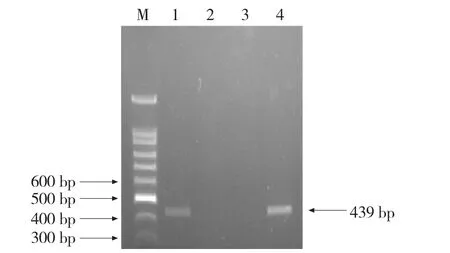
图1 烟粉虱体内ToCV的RT-PCR检测结果
采集北京海淀地区疑似感染ToCV番茄植株上的烟粉虱样本进行检测,提取烟粉虱RNA,以反转录的cDNA为模板,利用ToCV特异性引物ToCV-172和ToCV-610进行PCR扩增(图1)。产物测序后通过NCBI进行比对,产物序列与ToCV序列的相似性最高达到97%,表明北京海淀地区的样本感染了ToCV病毒。以北京海淀地区携带ToCV的烟粉虱样本为阳性对照,实验室健康番茄植株上采集的烟粉虱样本为阴性对照,检测采集烟粉虱样本的带毒情况(图1)。
2.2烟粉虱带毒情况检测
试验结果表明(表1),2013年采集自北京海淀、山西太原、山西运城、山东商河及陕西杨凌5个地区的烟粉虱样品携带ToCV;2014年北京海淀、山西运城、陕西杨凌、浙江杭州、山东商河和内蒙古6个地区采集的烟粉虱样品携带ToCV(图2)。浙江杭州、内蒙古等2013年并未发现烟粉虱携带病毒的地区,在2014年检测到ToCV的发生。山西、陕西、浙江及内蒙古4个地区采集的烟粉虱样本携带ToCV为首次报道。
2.3烟粉虱带毒率检测
对带毒地区的烟粉虱样本进行单头烟粉虱带毒情况检测,计算样品带毒率。检测结果表明(表2,图3),2013年各地区烟粉虱样品ToCV的带毒率均低于20%,2014年烟粉虱样品带毒率与2013年相比明显增加,除北京地区外,各地区烟粉虱样品带毒率均超过50%。新报道的山西、陕西、浙江及内蒙古4个地区,单头烟粉虱带毒率也明显增加。
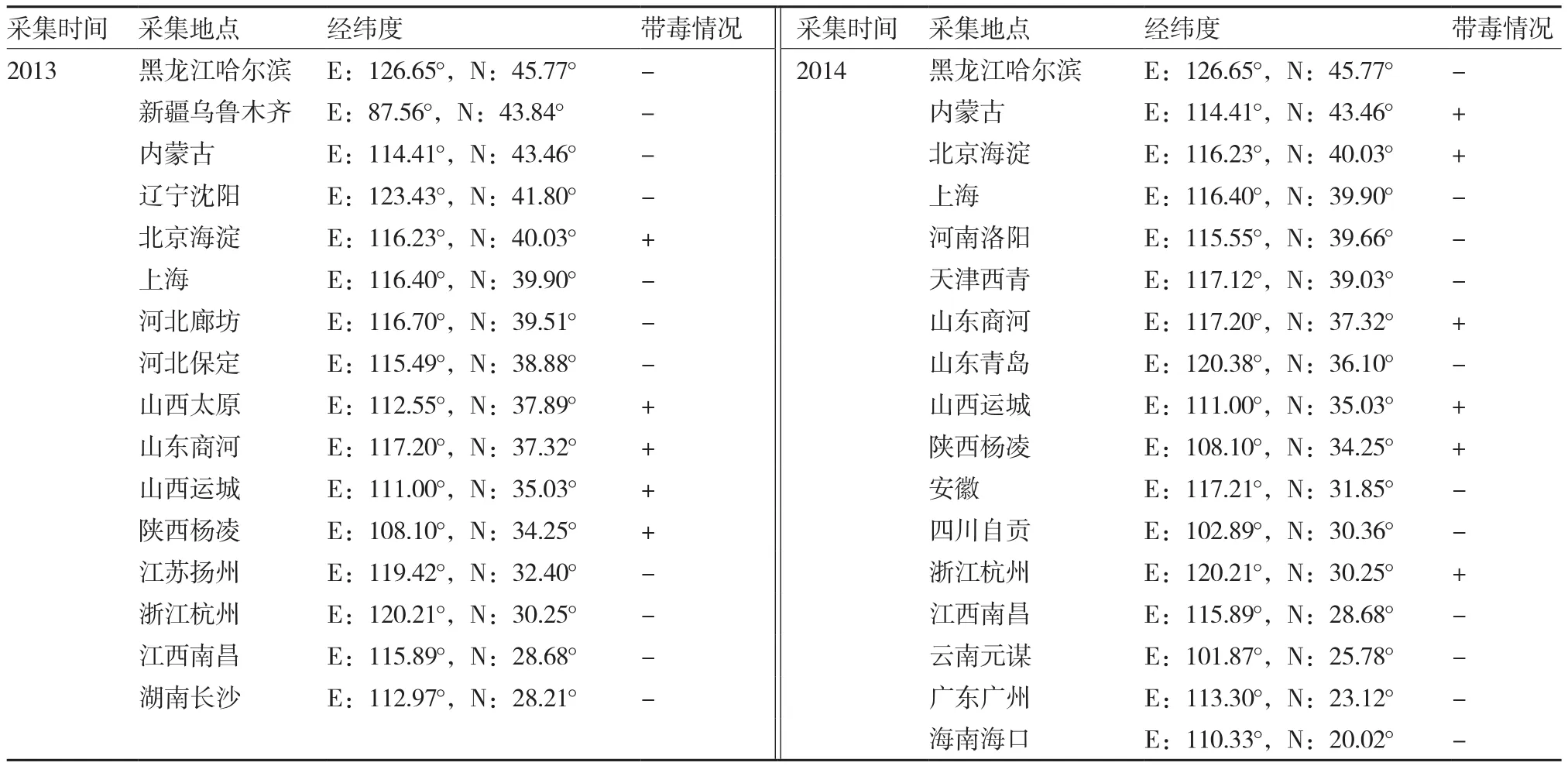
表1 烟粉虱采集地区及多头烟粉虱带毒情况
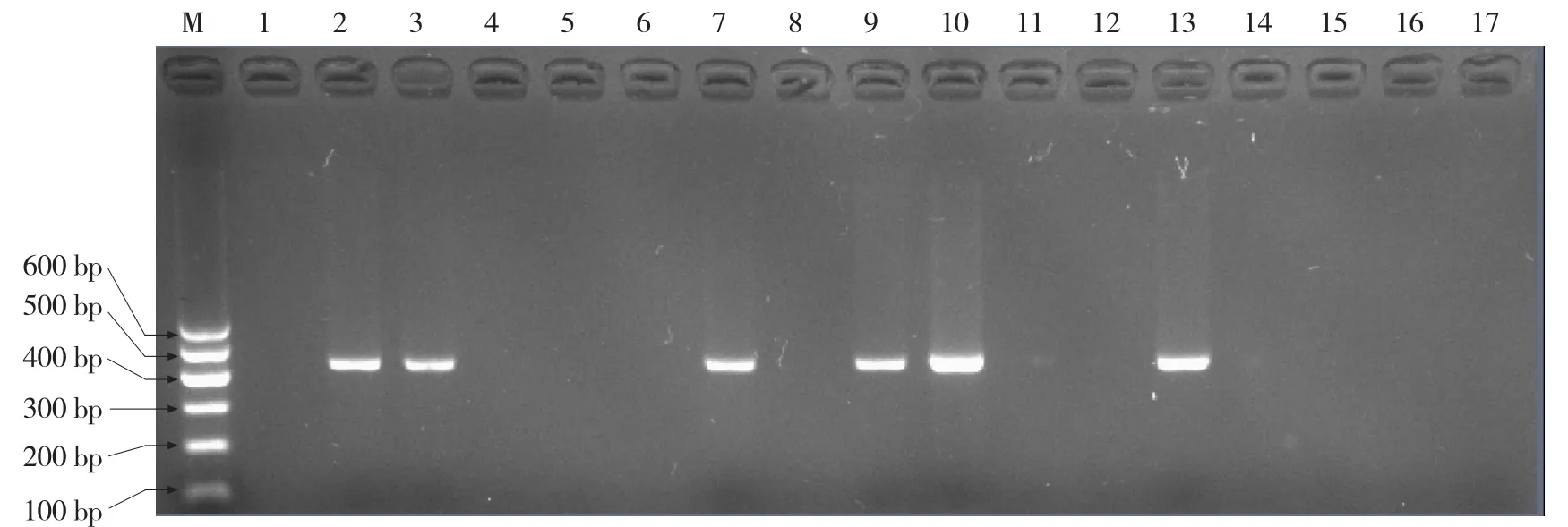
图2 2014年各地区烟粉虱带毒情况检测
3 结论与讨论
ToCV能造成番茄植株发育受阻,使其减产,造成重大的经济损失。ToCV发病前期症状不明显,发现症状时,病毒可能借由烟粉虱等媒介昆虫传播到其他植株上,随即造成ToCV的大范围暴发。因此,对烟粉虱携带ToCV情况的监测有利于预防和控制该病毒的发生,减少其带来的危害。

表2 2013~2014年单头烟粉虱带毒率
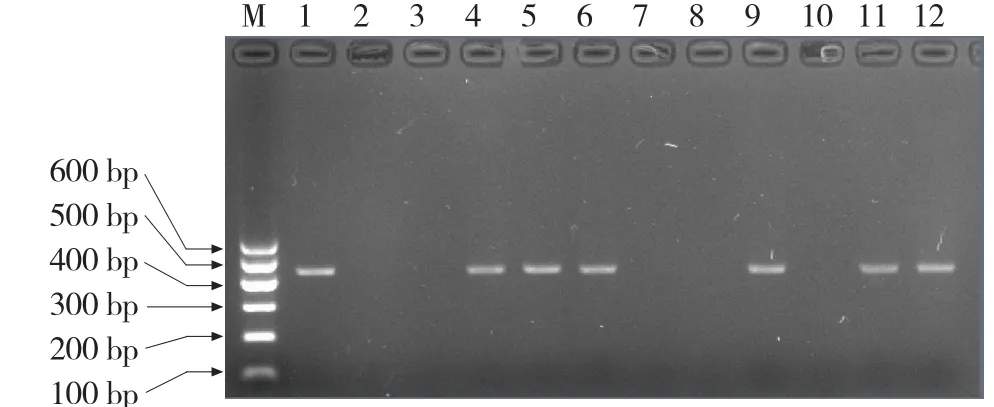
图3 2014年山东商河地区烟粉虱带毒率检测
本试验通过检测2013~2014年各地采集的烟粉虱样本携带ToCV的情况,监测全国ToCV的发生情况。研究结果表明,我国烟粉虱携带ToCV的地区除已报道的北京、江苏、山东之外(Zhao et al.,2013;Karwitha et al.,2014,;Zhao et al.,2014),新增了山西、陕西、浙江及内蒙古4个地区;2013年各地区烟粉虱带毒率均不超过20%,2014年烟粉虱带毒率除北京地区外,其他地区均超过50%。在新检测到ToCV的地区中,山西及陕西地区烟粉虱带毒率由2013年的低于20%急速上升到2014年的超过75%,浙江及内蒙古在2014年首次检测的带毒率均高于50%。由此可见,我国ToCV的发生正以北京、山西、山东为中心,迅速扩展,且发病率高,给我国番茄生产带来了巨大威胁。
ToCV是RNA病毒,主要媒介昆虫烟粉虱的传播方式为半持久性传播,因此,在采集样本时,病毒可能已经降解或未保留在烟粉虱体内,同时由于采集时间和采集地点等其他因素的影响,不排除已发生ToCV地区采集的烟粉虱样品未检出该病毒或带毒率低的情况。因此,今后需要对全国烟粉虱携带ToCV进行更加全面的检测,才能为防控ToCV的流行和传播提供科学指导。
参考文献
刘永光,魏家鹏,乔宁,李美芹,刘晓明,竺晓平.2014.番茄褪绿病毒在山东的暴发及其防治措施.中国蔬菜,(5):67-69.
Abou-Jawdah Y,El Mohtar C,Atamian H,Sobh H.2006.First report of Tomato chlorosis virus in Lebanon.Plant Disease,90 (3):378.
Alvarez-Ruiz P,Leyva-López N E,Méndez-Lozano J.2007.First report of Tomato chlorosis virus infecting tomato crops in Sinaloa,Mexico.Plant Pathology,56(6):1403.
Arruabarrena A,Rubio L,González-Arcos M,Maeso D,Fonseca M E N,Boiteux L S.2014.First report of Tomato chlorosis virus infecting tomato crops in Uruguay.Plant Disease,98(10):1445.
Barbosa J C, Teixeira A P M, Moreira A G,Camargo L E A,Bergamin Filho A,Kitajima E W,Rezende J A M.2008.First report of Tomato chlorosis virus infecting tomato crops in Brazil.Plant Disease,92(12):1709.
Bese G,Bóka K,Krizbai L,Takács A.2011.First report of Tomato chlorosis virus in tomato from Hungary.Plant Disease,95(3):363.
Castro R M,Hernandez E,Mora F,Ramirez P,Hammond R W.2009.First report of Tomato chlorosis virus in tomato in Costa Rica.Plant Disease,93(9):970.
Çevik B,Erkıß G.2008.First report of Tomato chlorosis virus in Turkey.Plant Pathology,57(4):767.
Dalmon A,Bouyer S, Cailly M,Girard M,Lecoq H,Desbiez C,Jacquemond M.2005.First report of Tomato chlorosis virus and Tomato infectious chlorosis virus in tomato crops in France.Plant Disease,89(19):1243.
Fiallo-Olivé E,Hamed A A,Moriones E,Navas-Castillo J.2011.First report of Tomato chlorosis virus infecting tomato in Sudan.Plant Disease,95(12):1592.
Karwitha M,Feng Z K,Yao M,Chen X J,Zhang W N,Liu X F,Tao X R.2014.The complete nucleotide sequence of the RNA1 of a Chinese isolate of Tomato chlorosis virus.Journal of Phytopathology,162(6):411-415.
Lett J M,Hoareau M,Reynaud B,Saison A,Hostachy B,Lobin K,Benimadhu S P.2009.First report of Tomato chlorosis virus in tomato on Mauritius Island.Plant Disease,93(1):111.
Louro D,Accotto G P,Vaira A M.2000.Occurrence and diagnosis of Tomato chlorosis virus in Portugal.European Journal of Plant Pathology,106(6):589-592.
Lozano G,Moriones E,Navas-Castillo J.2006.Complete nucleotide sequence of the RNA2 of the crinivirus Tomato chlorosis virus.Archives of Virology,151(3):581-587.
Papayiannis L C,Ioannou N,Dovas C I,Mailogka V I,Katis N I.2006.First report of Tomato chlorosis virus on tomato crops in Cyprus.Plant Pathology,55:567.
Parrella G,Scassillo L.2006.First report of Tomato chlorosis virus (ToCV)in Campania and of Tomato infectious chlorosis virus (TICV) in Calabria (Southern Italy).Informatore Fitopatologico,56(6):33-34.
Segev L,Wintermantel W M,Polston J E, Lapidot M.2004.First report of Tomato chlorosis virus in Israel.Plant Disease,88(10):1160.
Sundaraj S,Srinivasan R,Webster C G,Adkins S,Perry K,Riley D.2011.First report of Tomato chlorosis virus infecting tomato in Georgia.Plant Disease,95(7):881.
Wintermantel W M,Polston J E,Escudero J,Paoli E R.2001.First report of Tomato chlorosis virus in Puerto Rico.Plant Disease,85 (2):228.
Wintermantel W M,Wisler G C.2006.Vector specificity,host range,and genetic diversity of Tomato chlorosis virus.Plant Disease,90(6):814-819.
Wisler G C,Duffus J E,Liu H Y,Li R H.1998a.Ecology and epidemiology of whitefly-transmitted closteroviruses.Plant Disease,82(3):270-280.
Wisler G C,Li R H,Liu H Y,Lowry D S,Duffus J E.1998b.Tomato chlorosis virus:a new whitefly-transmitted,phloemlimited,bipartite closterovirus of tomato.Phytopathology,88(5):402-409.
Zhao L M,Li G,Gao Y,Liu Y J,Sun G Z,Zhu X P.2014.Molecular detection and complete genome sequences of Tomato chlorosis virus isolates from infectious outbreaks in China.Journal of Phytopathology,162(10):627-634.
Zhao R N, Wang R,Wang N,Fan Z F,Zhou T,Shi Y C,Chai M.2013.First report of Tomato chlorosis virus in China.Plant Disease,97(8):1123.
Be on Alert of Rapid Diffusion of Tomato chlorosis virus Transmitted by Whitefly in China
ZHENG Hui-xin1,2,XIA Ji-xing2,ZHOU Xiao-mao1,ZHANG You-jun2*
(1Institute of Pesticide Science,Hunan Agricultural University,Changsha 410128,Hunan,China;2Institute of Vegetables and Flowers,Chinese Academy of Agricultural Sciences,Beijing 100081,China)
Abstract:In this study,we monitored the carrying rate of ToCV of Bemisia tabaci in major tomato production areas of China in 2013 and 2014.We discovered that in 2013,among all B. tabaci samples collected from 16 different areas of China,those from Yuncheng Shanxi,Taiyuan Shanxi,Shanghe Shandong,Yangling Shaanxi,Haidian Beijing carried ToCV,but the virus carrying rates were all below 20%.In 2014,among B. tabaci collected from 17 areas,those from Haidian Beijing,Hangzhou Zhejiang,Shanghe Shandong,Yuncheng Shanxi,Yangling Shaanxi,and Inner Mongolia were infected by ToCV.The virus carrying rates,except Beijing,were all above 50%.ToCV was reported for the first time in Shanxi,Shaanxi,Zhejiang and Inner Mongolia,and the rate of ToCV-infected B. tabaci increased significantly in 2014,compared with that in 2013.Thus,high attention should be paid to the trend of ToCV rapid diffusion in China.
Key words:Bemisia tabaci;Tomato chlorosis virus;Detection
*通讯作者(
Corresponding author):张友军,男,研究员,博士生导师,专业方向:蔬菜害虫分子生物学、生态学,害虫抗药性机理和害虫综合防治,E-mail:zhangyj@mail.caas.net.cn
收稿日期:2015-09-01;接受日期:2015-10-19
基金项目:国家科技支撑计划项目(2012BAD19B01);蔬菜有害生物控制与优质栽培北京市重点实验室项目

